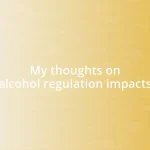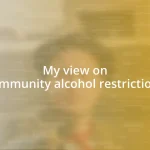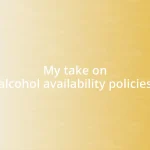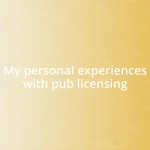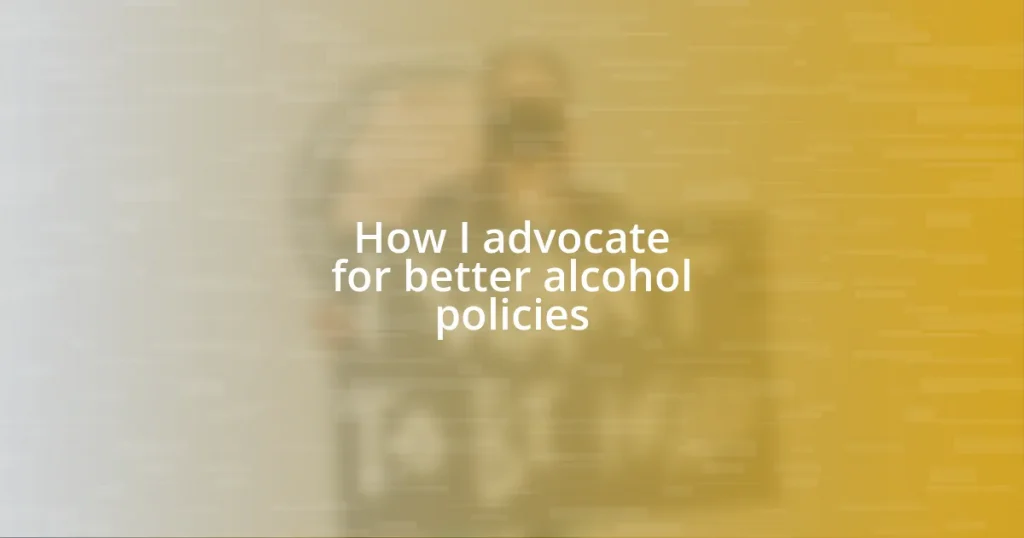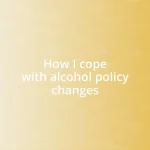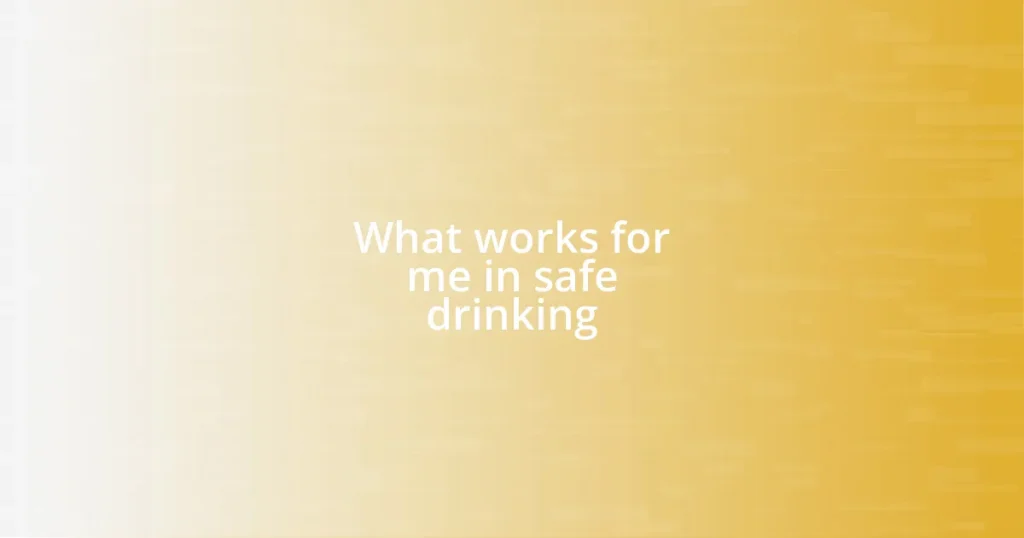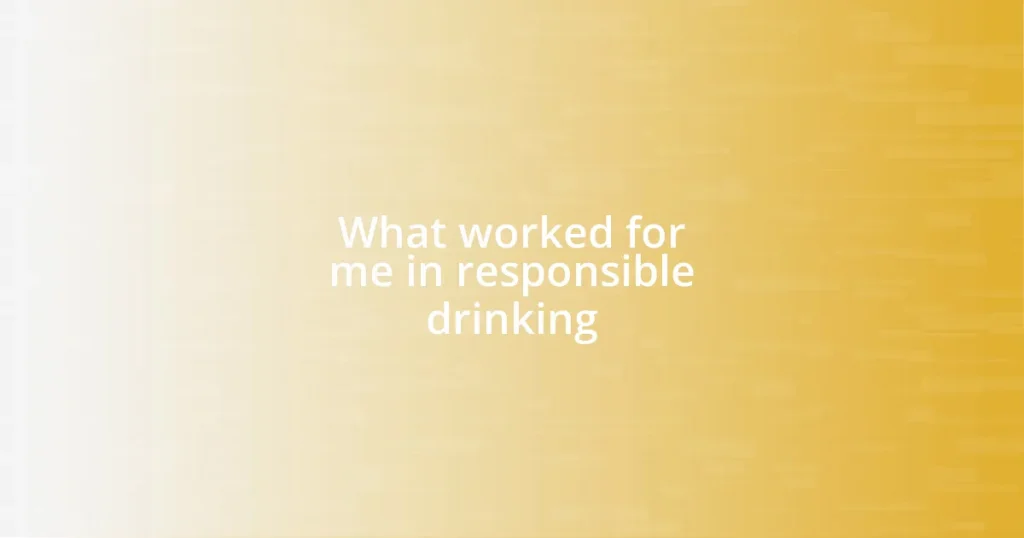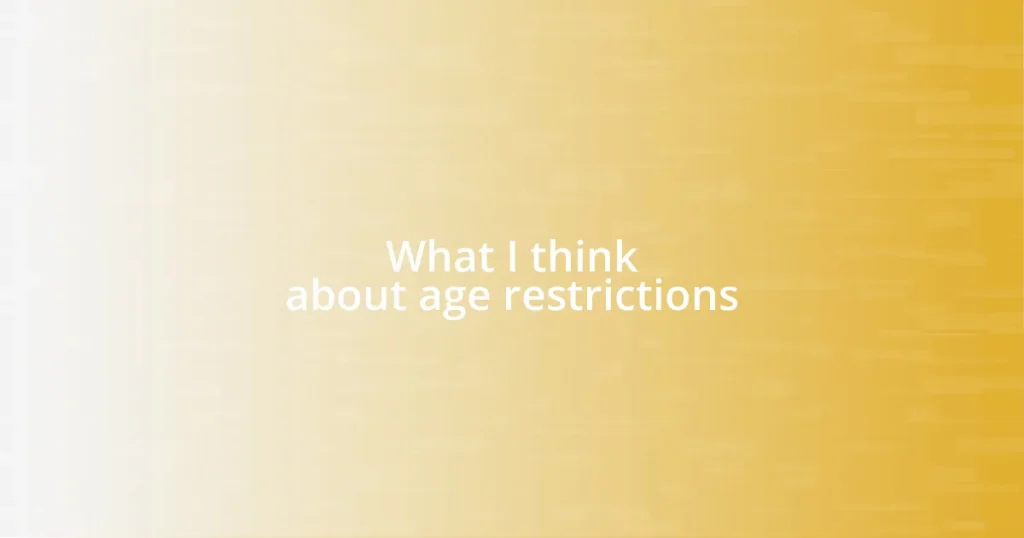Key takeaways:
- Understanding alcohol policy issues is crucial for addressing public health and community safety, as inadequate policies can lead to severe social consequences.
- Effective advocacy requires collaboration with diverse stakeholders, including public health advocates, community leaders, and local businesses.
- Building a coalition involves setting clear goals, maintaining communication, and celebrating successes to sustain momentum and trust among members.
- Combining emotional storytelling with data-based evidence enhances the persuasiveness of advocacy messages, making them more relatable and impactful.
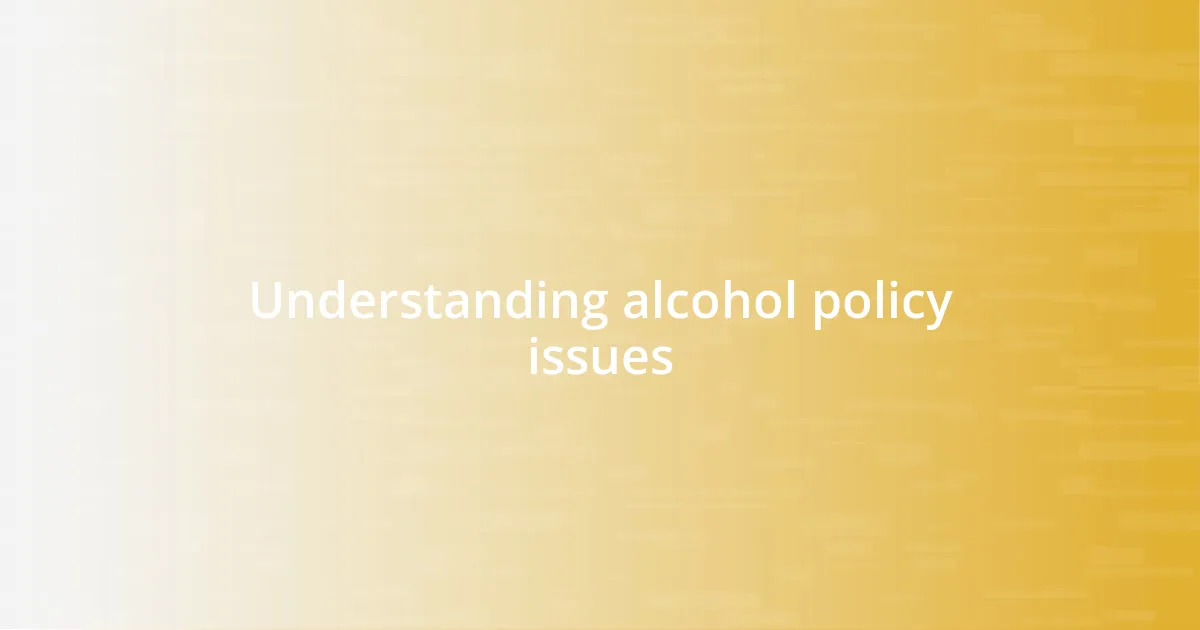
Understanding alcohol policy issues
Understanding alcohol policy issues is essential because they impact public health and community safety. For example, I remember attending a community meeting where locals shared heart-wrenching stories about how alcohol abuse affected their loved ones. Hearing these experiences made it clear that our policies often don’t account for the real-life consequences faced by individuals and families.
When we look at the regulations surrounding alcohol sales, we often find contradictions. For instance, while there are age restrictions to prevent underage drinking, I’ve seen countless ads targeting young adults, glamorizing excessive consumption. Doesn’t it make you wonder how effective our policies truly are in protecting vulnerable populations?
Moreover, the consequences of inadequate alcohol policies can ripple through entire communities, leading to increased healthcare costs and crime rates. I once spoke with a healthcare worker who shared how often they encounter alcohol-related incidents in emergency rooms. This opened my eyes to the need for a more comprehensive approach to alcohol regulation—one that not only focuses on prevention but also addresses the root causes of alcohol abuse.
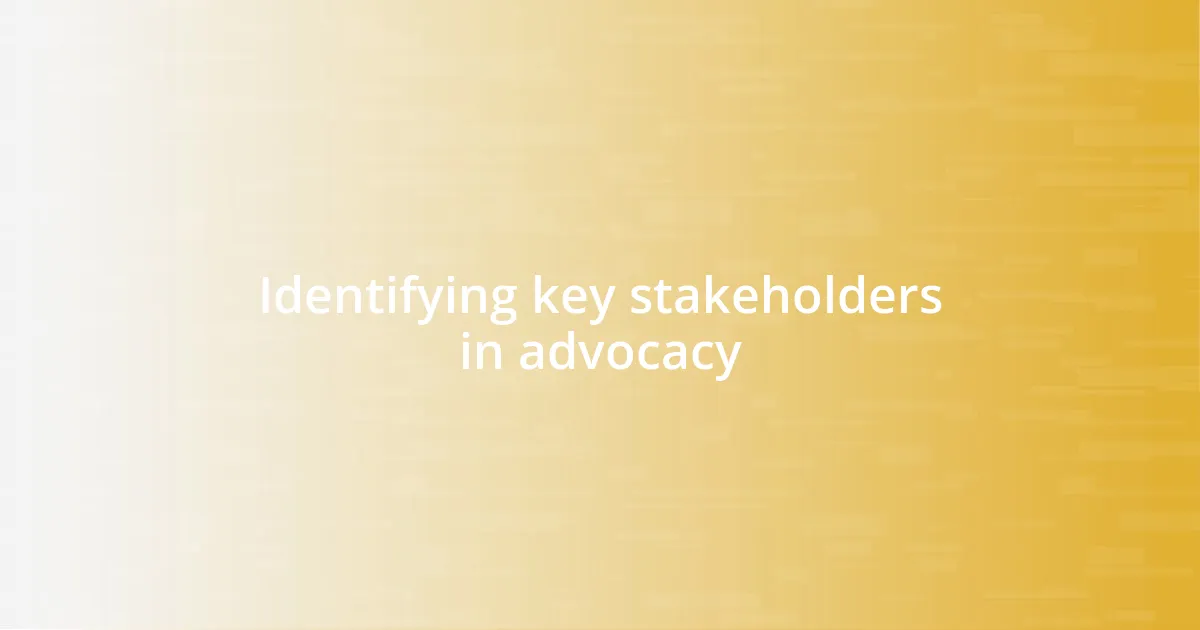
Identifying key stakeholders in advocacy
Identifying key stakeholders in advocacy is a crucial step toward creating effective alcohol policies. In my experience, it’s not just about approaching lawmakers—real change requires collaboration with a diverse group of individuals and organizations. When I started my advocacy journey, I realized that everyone from healthcare professionals to local business owners has a stake in how alcohol is regulated. Each perspective provides valuable insights that can shape more informed policies.
Here’s a quick list of some key stakeholders to consider:
- Public Health Advocates: They understand the health implications of alcohol consumption.
- Community Leaders: These individuals can represent local sentiments and needs.
- Law Enforcement Officials: Their insights into crime rates related to alcohol can strengthen advocacy points.
- Educators: They provide perspectives on the impact of alcohol on youth and education.
- Non-profit Organizations: Many work tirelessly on substance abuse prevention and recovery initiatives.
- Local Businesses: They can help balance economic interests with community welfare.
The range of stakeholders is as varied as the issues themselves. I once teamed up with a local non-profit focused on youth programs, and their firsthand stories of preventing underage drinking illuminated aspects of the problem I hadn’t considered before. It’s through these connections that I learned that collaboration is key; when diverse voices come together, they create a more compelling case for change.
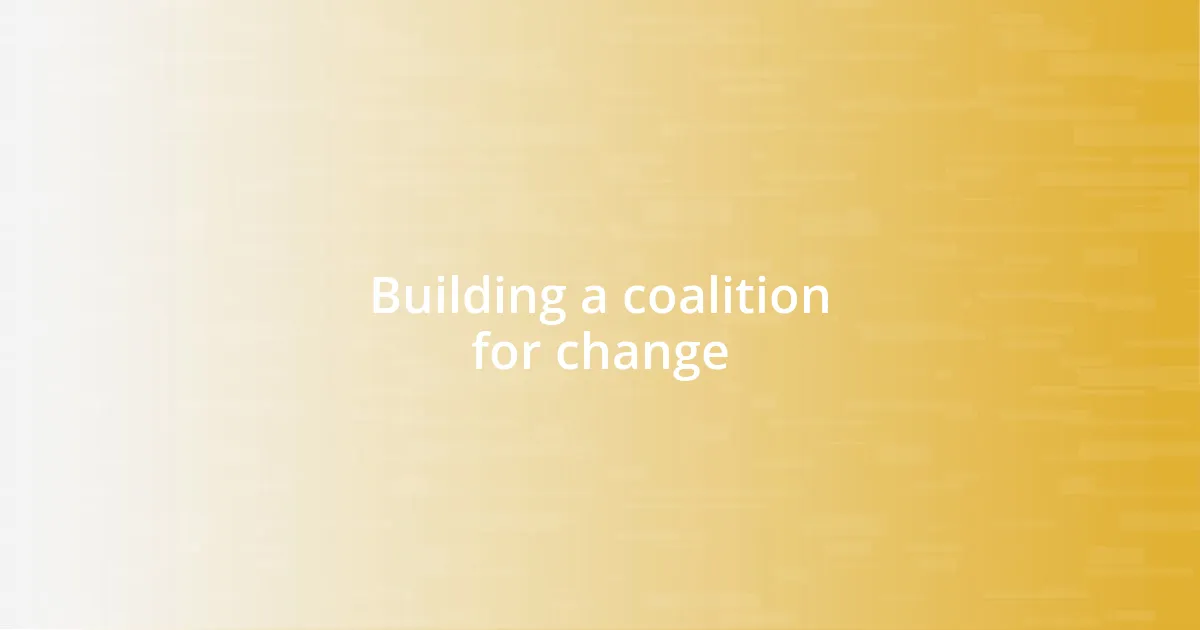
Building a coalition for change
Building a coalition for change involves bringing together individuals and organizations who share a common vision for better alcohol policies. I remember the first meeting I organized, and the energy in the room was palpable. We were all passionate about creating a safer environment, and that camaraderie made it clear that our coalition could amplify our voices. By collaborating, we not only share resources, but we also build trust among community members, which is crucial for sustainable change.
When forming a coalition, it’s essential to establish clear roles and a shared mission. I’ve seen firsthand how setting specific goals helps keep everyone aligned. For instance, I once worked with a group focused on reducing underage drinking. We developed a strategic plan involving social media campaigns, community workshops, and direct outreach to schools. Each member had unique strengths that contributed to our success. This blend of talents and perspectives can lead to innovative solutions that address the complexities of alcohol-related issues.
In my experience, consistent communication and regular check-ins can strengthen a coalition. I recall a challenging period when enthusiasm waned after initial victories. We decided to hold monthly meetings to celebrate small wins and reassess our strategies. This approach re-energized the group and reminded us why we came together in the first place. I cannot stress enough how these personal connections and ongoing support can significantly enhance our impact.
| Element | Description |
|---|---|
| Collaboration | Bringing together diverse stakeholders strengthens advocacy efforts. |
| Shared Goals | Establishing clear roles and a unified mission helps maintain focus. |
| Communication | Regular meetings foster relationships and keep momentum going. |
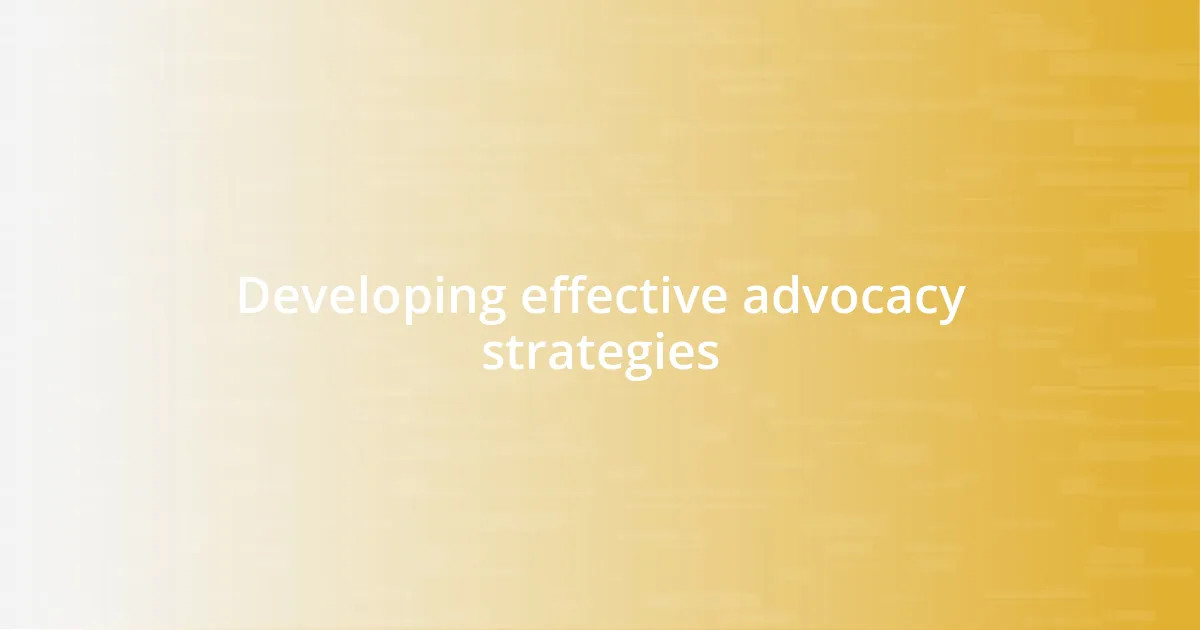
Developing effective advocacy strategies
Creating effective advocacy strategies is about more than having a plan; it’s about understanding the landscape in which you’re operating. I often find that being adaptable is crucial. For instance, when I first began my advocacy work, I encountered unexpected resistance from community members. It was a wake-up call that made me rethink our messaging and engage more personally. Listening to their concerns transformed my approach and deepened my relationships, eventually leading to a stronger advocacy position.
One invaluable strategy I’ve discovered is the power of storytelling. When I shared my own experiences with alcohol’s impact on my family, the room fell silent, and I could see the shift in perspectives. I realized that we often connect on an emotional level, and weaving personal narratives into our strategies makes the issue more relatable. Have you ever noticed how a heartfelt story can cut through the noise? This emotional engagement fosters empathy and encourages others to rally behind the cause.
Another essential element is leveraging data to back up your advocacy messages. While I’ve never been a numbers person, I learned how critical statistics can be in persuading policymakers. I vividly remember a meeting where I highlighted local data showing the increase in alcohol-related incidents over the past few years. The shift in the lawmakers’ attitudes was palpable. They responded not only to the facts but also to the urgency they represented. This experience taught me that combining emotional appeal with solid evidence creates a powerful advocacy strategy that can drive change.
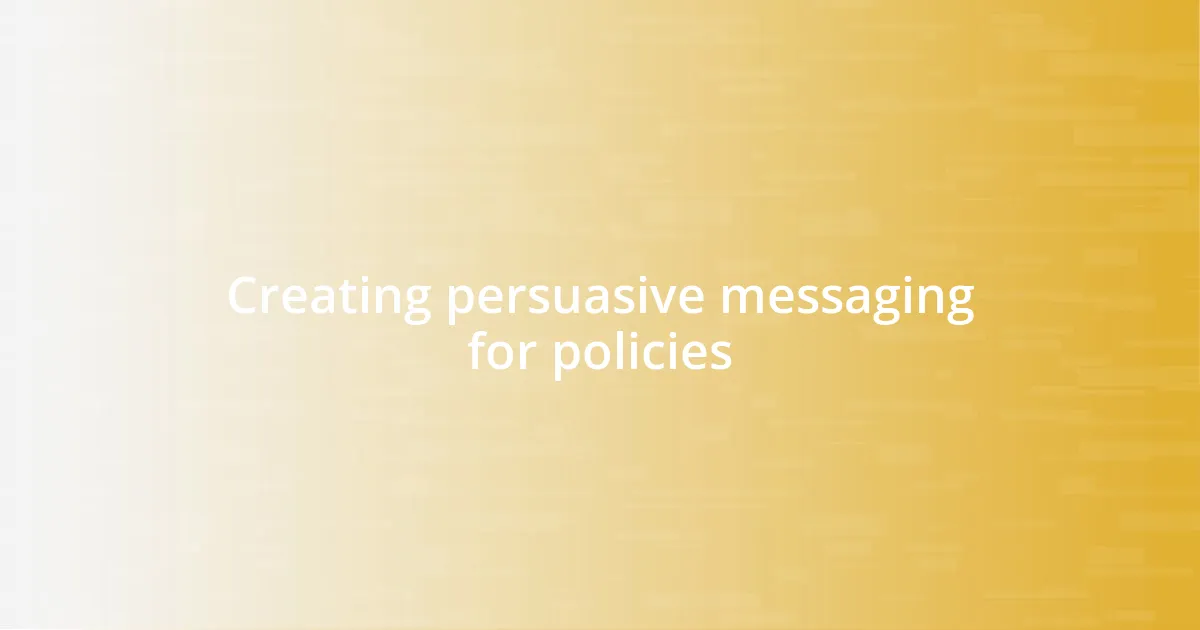
Creating persuasive messaging for policies
Creating persuasive messaging for policies requires a delicate balance of emotion and rationality. I recall a time when I crafted a campaign focused on reducing binge drinking on college campuses. Instead of bombarding students with statistics about the dangers, I shared a video featuring real students discussing the devastating effects on their friends and families. This personal touch established a connection that facts alone often fail to evoke, leading many to reconsider their choices. Have you ever thought about how a personal story can resonate more than a chart full of numbers?
One thing I’ve learned is the importance of tailoring the message to the audience. During a presentation to local lawmakers, I quickly realized they responded better to economic arguments than moral ones. So, I shifted my approach, highlighting how better alcohol policies could lead to reduced healthcare costs and improve community productivity. As soon as I made that pivot, their interest piqued; it felt like a light bulb moment for both me and them. Isn’t it fascinating how understanding someone’s priorities can reshape the entire conversation?
Moreover, employing visuals can enhance the persuasiveness of your message significantly. When I attended a community forum, I used infographics to present trends in alcohol-related harm visually. The ease of understanding the data was remarkable; you could see attendees nodding as they processed the information. It reminded me that sometimes we all need a little help in seeing the bigger picture. How often do we overlook the importance of visual elements in our advocacy efforts?




